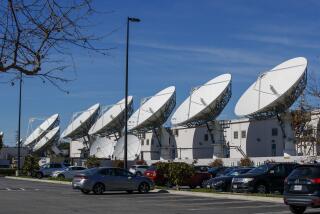AT&T; Plans a 5.6% Cut in Long-Distance Rates
PITTSBURGH — American Telephone & Telegraph’s domestic long-distance telephone rates are expected to fall 5.6% on June 1 as the company passes along to customers its savings from reduced charges for access to local phone systems, Chairman Charles L. Brown told shareholders at the company’s 100th annual meeting here Wednesday.
Brown also announced quarterly financial results that were slightly below the expectations of many Wall Street analysts, and he disclosed that AT&T; is negotiating to buy most of the assets of a Santa Clara, Calif.-based unit of Honeywell to further bolster its semiconductor manufacturing capacity.
AT&T; officials said they asked the Federal Communications Commission on Wednesday for permission to lower long-distance rates in an action that they said would cut AT&T; customers’ bills by about $1.1 billion annually. They said that the price reductions would just about offset a $1-a-month additional charge that local telephone companies will begin charging residential and single-line business customers June 1.
For example, the daytime, weekday rate for a call from Los Angeles or San Diego to New York will fall to $2.33 for five minutes from the current $2.53. The weekend rate will drop to 93 cents from $1.01.
The average residential long-distance telephone bill is about $15.50 a month; the reduction would represent a savings of about 85 cents, according to AT&T.;
The rate reductions would also apply to WATS, or Wide Area Telecommunications Service, and the company’s toll-free 800 number service. Rates to 87 international points are to be reduced up to 6.6%, the company said.
The reductions were in line with earlier predictions, AT&T; officials noted. The FCC has sought increased local charges to end the historic subsidizing of local service by long-distance fees.
Analysts said they expect further pressure on AT&T;’s profit margins from the proposed rate reductions. They said AT&T;’s savings from access charges will not fully make up for its loss in long-distance revenue.
AT&T; said the company’s net income rose 55% for the period ended March 31 to $354 million from $227 million in the like period of 1984. Revenue was $8.3 billion, compared to $8.13 billion in the comparable period of 1984.
At a morning news conference, Brown said the financial results offered “no surprises.” But several Wall Street analysts promptly reduced their 1985 earnings forecasts for the telecommunications company, noting that revenue from sales of AT&T; services and from rentals had both declined during the quarter compared to the year-earlier period.
Harry Rosenthal, an analyst with Bear, Stearns & Co. in New York, said the company’s revenue from interstate long-distance service had declined in the first period versus the comparable period of 1984 and that AT&T; continued to lose money from its intrastate service. MCI Communications “is continuing to gain market share and, even if these results are only slightly below expectations, it could mean more bad news as the year progresses,” Rosenthal said.
Rosenthal lowered his per-share earnings estimate for all of 1985 to $1.60 from $1.70. Steven Chrust, an analyst with Sanford C. Bernstein in New York, on Wednesday reduced his estimate to $1.65 from $1.75.
Buying Honeywell Unit
AT&T; officials said the company has signed a letter of intent to purchase most of the assets of Honeywell’s Synertek units in Bangkok, Singapore, Santa Cruz and Munich. Synertek products include a variety of electronic parts, including memory chips and microprocessors. The unit has lost money in recent years, and last December Honeywell discontinued most operations at the Santa Cruz-based unit and laid off most of its 1,200 U.S. employees.
Synertek’s Santa Clara facilities are not being considered by AT&T;, however, and are still for sale by Honeywell, officials added.
AT&T; officials said the purchase will improve AT&T;’s fledgling semiconductor marketing effort in Europe and Asia. Brown said, however, that most semiconductors manufactured with use of the Synertek assets will be for in-house purposes.
Officials also said AT&T; next week will begin marketing high-speed microprocessing chips, advanced design electronic parts that AT&T; had until now reserved for use within the company.
More to Read
Inside the business of entertainment
The Wide Shot brings you news, analysis and insights on everything from streaming wars to production — and what it all means for the future.
You may occasionally receive promotional content from the Los Angeles Times.











